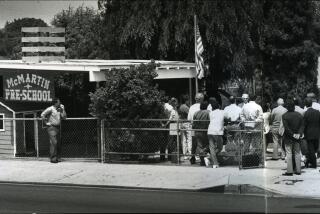D.A.’s Office Gears Up on Strategy for the McMartin Trial
- Share via
With all seven defendants in the McMartin Pre-School molestation case ordered to stand trial, deliberations in the controversial case now shift from the courtroom to the district attorney’s office, where several critical decisions must soon be made.
Los Angeles County Dist. Atty. Ira Reiner and his top advisers have already met several times with the McMartin prosecutors to decide a number of crucial questions:
- Should all charges against any of the seven defendants be dropped?
- Should any of the 135 molestation and conspiracy counts and 14 child witnesses be eliminated?
- Which prosecutors will make up the team that will take the case to trial?
Chief Deputy Dist. Atty. Gilbert Garcetti said Friday that the top district attorney officials are discussing the individual defendants, counts and witnesses and will issue an announcement this week on the dimensions of the case that they will take to trial.
Ordered last week to face charges were school founder Virginia McMartin, 78; her daughter, Peggy McMartin Buckey, 59; McMartin’s grandchildren, Ray Buckey, 27, and Peggy Ann Buckey, 29; and three former teachers, Betty Raidor, 66; Babette Spitler, 37, and Mary Ann Jackson, 58.
All but key defendant Ray Buckey, who faces 82 counts, and his mother, Peggy McMartin Buckey, who faces 24 counts, are free on bail. Ray Buckey is being held without bail; his mother’s bail was reduced Friday from $1 million to $500,000.
The seven are to be arraigned Jan. 23 before Los Angeles Superior Court Judge Aurelio Munoz, supervising judge of the criminal courts. Munoz will assign the case to a judge agreeable to both sides. Each has the right to reject one judge, but it remains unclear whether that means the seven defense attorneys are entitled to challenge seven choices.
It is also not clear whether the seven defendants will be tried together or separately. The seven may not be ready for trial at the same time, or their attorneys may ask for separate trials in an attempt to exclude indirect evidence against their clients.
In reorganizing his prosecution team, Garcetti said he has decided to replace Deputy Dist. Attys. Glenn Stevens and Christine Johnston but probably will retain the chief prosecutor, Lael Rubin. He said “no final decision has been made” as to which prosecutors will be added.
The personnel change appears related to media reports in the final months of the preliminary hearing that two of the three prosecutors had doubts about the strength of the evidence.
In September, one prosecutor told The Times that four of the seven may be innocent, saying that they appeared to be victims of suggestive interviewing techniques by which therapists led children into saying and believing that they had been molested.
The most important decisions ahead for the prosecution center on the strength of the evidence, because the burden of proof is much greater at trial where prosecutors must prove the defendants’ guilt “beyond a reasonable doubt.”
In the preliminary hearing, they needed only to show “probable cause” or raise a “strong suspicion” that the crimes had been committed.
“All that need be shown at a preliminary hearing is that you’ve got something, although that could easily be rebutted at trial,” said Municipal Judge Aviva K. Bobb, who presided over the 18-month hearing.
At trial, however, the California Penal Code states that a defendant in a criminal case is entitled to an acquittal unless his guilt has been proven beyond a reasonable doubt and jurors, after considering all the evidence, feel “an abiding conviction, to a moral certainty, of the truth of the charge.”
And the concept of “reasonable doubt” can be hard to define.
For example, Bobb explained, “You can’t say that it is beyond all possible doubt when you cross the street you won’t get hit. But you can choose to cross with the expectation that you won’t be. We make important decisions based on this concept of ‘beyond a reasonable doubt’ that something will happen to you.”
Prosecutor’s Scale
Garcetti said he thinks of various levels of proof in numerical terms on a scale of 0-100, with strong suspicion at about 35 or 40, a preponderance of the evidence at 50.1, and proof beyond a reasonable doubt much closer to 100. How much closer, he wouldn’t say.
Meanwhile, with the grueling proceedings behind her, Bobb on Friday characterized the hearing as “unique and difficult” and said it raised a host of issues that the system must grapple with to avoid a future replay.
She said there needs to be a legislative or judicial “re-determination” of the discovery aspects of preliminary hearings. “Discovery” refers to proceedings held to provide the defense with material that could lead to admissible evidence. Such proceedings consumed much of the McMartin hearing.
She also said the marathon hearing would have been considerably shorter had prosecutors not linked the defendants by a combined count of conspiracy--which accounted for 80% to 90% of the cross-examination, she said.
Bobb also said the prosecutors should have called different child witnesses to testify against each of the defendants.
“They had one child testifying against seven defendants,” she said. “If you have a population of 400 children (who could testify), why make one do all the work?
“But it was not lengthy when you consider, for example, that one child who was on the stand for 17 hours over eight days testified to 21 counts against Ray Buckey and nine against a variety of others. That works out, ultimately, to her being on the stand for a half-hour per felony count.”
Decision Explained
Defense attorneys were angry when Bobb insisted on a single preliminary hearing for the seven defendants. She explained her decision Friday.
Given the case--the conspiracy count, the counts that involved three to five defendants each, the large number of scheduled child witnesses--she said she believes that a combined preliminary hearing was “the only way at that time” to accommodate the rights of the defendants and the rights of the children and to avoid their having to testify more than once.
She also said that as child witnesses play an increasing role in criminal prosecutions, their needs must be addressed.
The closed-circuit television system used with only one child in the McMartin hearing worked very well, she said.
“I felt the child was more able to assert his memory of the facts than children were when they were on the witness stand. My sense is that what we were looking for--the minimizing of intimidation--really occurred.”
The judge also said she believed that young witnesses need to be better prepared for their court experience. “Often they feel they have to remember stuff they don’t remember,” she said. “They don’t know when to say, ‘I don’t remember.’ ”
More to Read
Sign up for Essential California
The most important California stories and recommendations in your inbox every morning.
You may occasionally receive promotional content from the Los Angeles Times.












